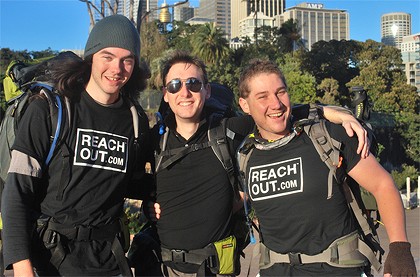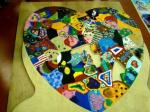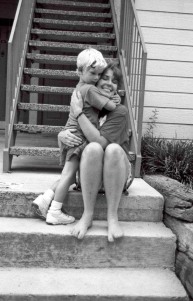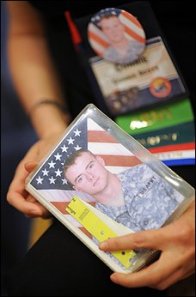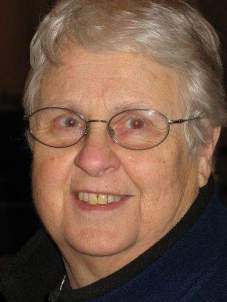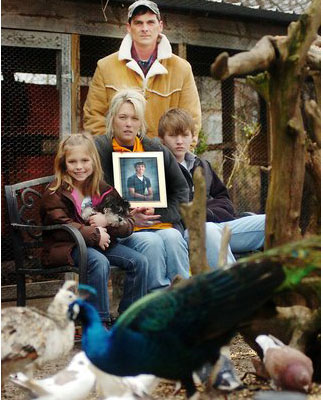
Missy Cangemi, holding a picture of her son Storm, poses with her husband, Paul, and their two children, Katie and Cole, inside the aviary Storm built. (Hannah Reel, Natchez Democrat)
[Editor’s note: “Links to Suicide Grief Stories …” is a SPNAC series featuring stories of survivors of suicide loss — about the effect their loved one’s suicide has had on them and how they are coping with their grief. FJC]
In “A Future Lost: Vidalia [Mississippi] Teen ‘Born Good,’ Dies Too Early,” reporter Vershal Hogan writes about the family of Storm Cangemi, a 16-year-old boy who died by suicide in December.
After any death, fragments of the person who is gone linger — old photographs, trinkets they collected, unfolded laundry — all reminders that in the spaces between the fragments is a loss-sized hole. The [Cangemi] family has a table of photographs in the living room, can still access his MySpace page and can even see his features in the faces of their two other children, but the biggest physical reminder Storm left was his aviary.
Mixing a bucket of seed and other birdfeed, Paul said the first time he ever fed the birds was after Storm died: “At first, I was so angry about having to do this,” Paul said. “I would fuss and rage and say, ‘This was Storm’s thing, not mine.’ But now it’s something I can do to remember him.” [His mother said,] “We put a bench out here [in the aviary) and would watch Storm while he fed them, and now keeping them is a way to be close to him.” (Natchez [Mississippi] Democrat)
In “Blues Blowout Benefits Iowa Public Radio,” reporter Mary Stegmeir covers a benefit appearance by award-winning blues singer Janiva Magness, who lost both of her parents to suicide by the time she was 16 years old.
At Saturday’s Blues Blowout the 53-year-old proved it’s her unbridled joy for the genre — not her painful past — that truly sets her apart from the rest. As Magness sang hits from her 2008 album “What Love Will Do,” a twinkle lit up her eyes. “You know, I love my job,” the headliner told the Electric Park Ballroom crowd. “I feel like I’m a very, very lucky woman.” (Waterloo-Cedar Falls Courier)
There is an in-depth profile of Magness on the Foster Care Month website, in which she says,
“I have a life today I could never have imagined. You know, your fate does not have to be your destiny. Fate is what you are handed. Destiny is about what you could be. I’m living proof. The tragedies of my life no longer define me.”
In “Mum Tells Town Councillors of Daughter’s Suicide,” the Derry Journal reports on suicide survivor Janice Doherty’s appearance before the Buncrana, Ireland, Town Council to promote the launch of the initiative Buncrana Community Combating Suicide.
“It only takes a moment to change your life forever: Mine changed 15 months ago when my daughter Rachael took her own life … For me, now my days are just about being here: I have struggled this past 15 months, not an hour going by that I am not thinking about my beautiful daughter … But I have to look to the future, I have to move on and I have to live. It is terrible upsetting that I cannot reach out and touch Rachael anymore.
“Part of me died that day too. But I have to get on with my own life in order to face the future.” (Derry Journal)
In “Mental Illness Still Can Come with Stigma,” Judy Gillentine writes about how her mother’s death by suicide in 1992 led her to become a member of the National Alliance on Mental Illness (NAMI).
As so often times happens with death, we divide our life with before and after; before my mother died and after my mother died. It was 1992, the year my mother killed herself and the year I first became acquainted with NAMI … Wrestling with guilt and questions that can only come from being raised by a clinically depressed mother, I sought out this organization for support. At that time, they were filling slots for a class taught by survivors called The Journal of Hope. Correctly titled, this educational class would become my beacon. And with it a seed began to grow that would make me the advocate for the mentally ill that I am today. (Longview [Texas] News-Journal)
In “Suicide Leaves Big Sister Puzzled,” reporter John Grant Emeigh writes about Rena Puccinelli, whose brother Reno died by suicide five years ago when he was 41 years old.
“We were all blindsided by it,” Rena said. “Nothing made any sense. We were trying to put things together, but nothing made any sense,”
He showed no signs of being upset or depressed. He said nothing about feeling suicidal. He left no note. Family members were stunned after his death was ruled a suicide. Rena said they went over every possible reason but came up with no conclusion. For several months, Rena rarely left home, ashamed to show her face. Her father refused to speak about it.
A year after his death, she concentrated on work. “I tried to stay busy so I didn’t have to think about it,” she said. It didn’t work. She said she thought of her little brother every day. (Billings Gazette)
In “Suicide at Bobst,” Esmeralda Williamson-Noble, whose 20-year-old son, Andrew, died by suicide only three months ago, writes about her struggle to understand what happened at the college where he died.
My son’s death was a bolt out of the blue for my family. And all of us, privately and with each other, go over and over what happened. We go over and over what we know of Andrew; we ask ourselves what, if anything, we may have missed. What set of circumstances, people, instances, had they been different, would have prevented, foiled, stopped, that fateful night’s events from coming together and ending in my son’s death? (Huffington Post)
[Editor’s note: By way of a personal update on the final item, above, Esmeralda was among a small group of suicide prevention advocates at the AFSP/SPAN Legislative Institute in Washington, D.C. on Monday-Tuesday, Mar. 8-9, where I spoke on a panel and the lot of us visited our congressional representatives on Capitol Hill to promote suicide prevention. She blogs at “Forever Invictus,” where she has shared about her loss ever since a post the day of her son’s death on Nov. 3, 2009.
[The abridged URL for this post is http://tinyurl.com/GriefStories08 .]
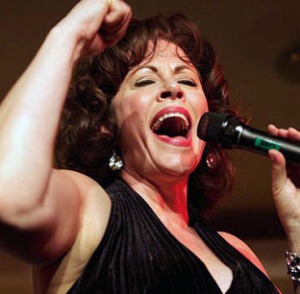

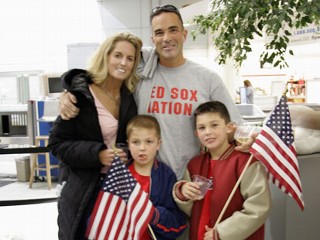
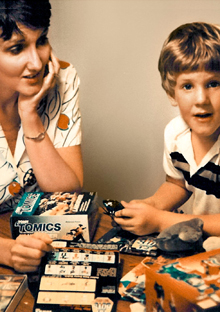
 Therese J. Borchard, founder of the blog “
Therese J. Borchard, founder of the blog “

